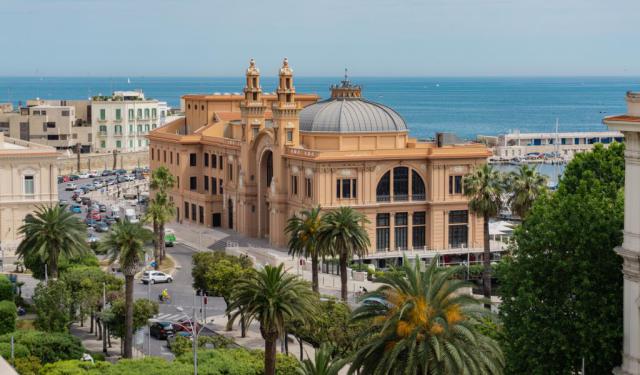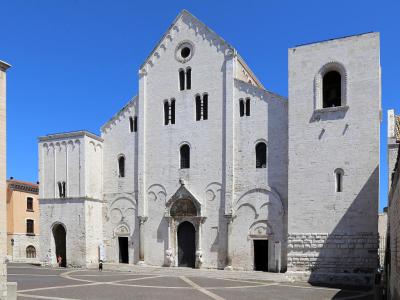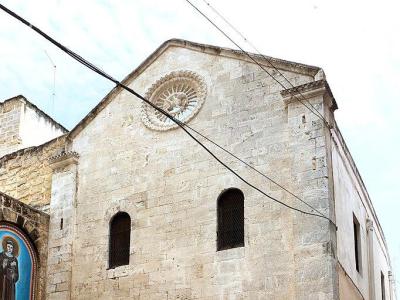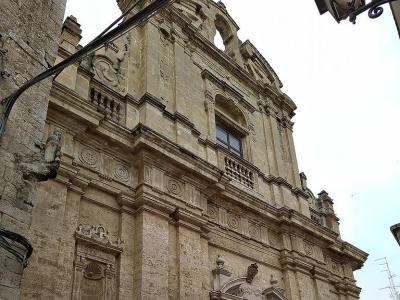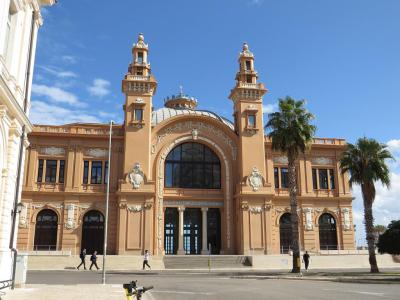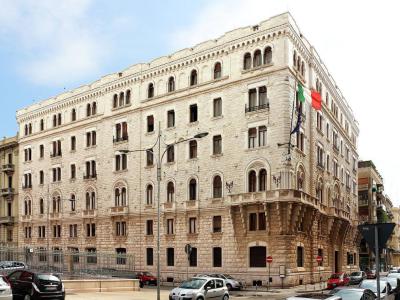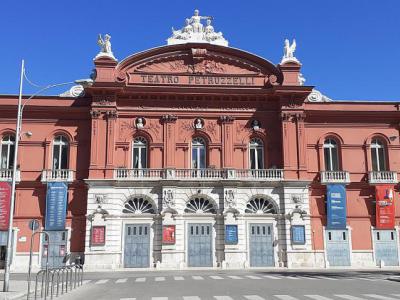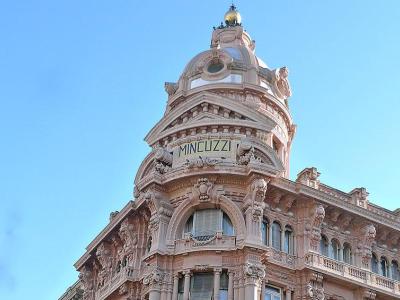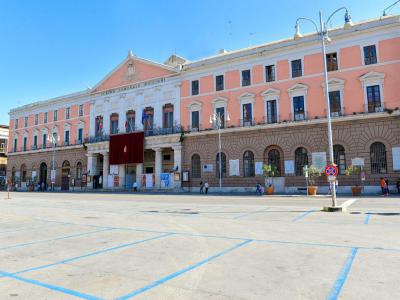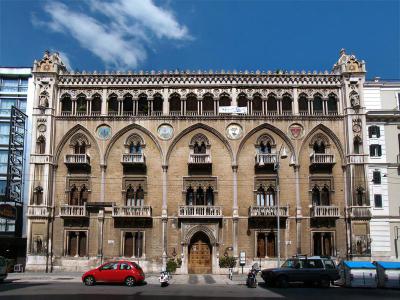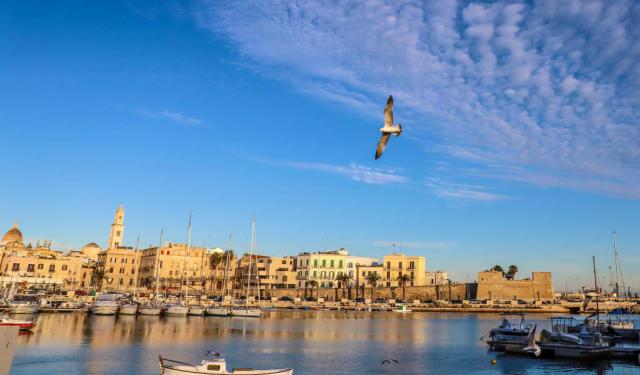Bari's Historical Buildings Walking Tour (Self Guided), Bari
One of the dicta usually attributed to an 18th-century German poet Johann Wolfgang von Goethe is that "Architecture is the frozen music." To this, one can only add that it's the music of time, especially when it comes to places like Bari, where the intricate details and craftsmanship of historic buildings are a testament to the human ambition to leave a lasting impression and the triumph of human creativity over the constraints of time.
Indeed, this cute port town on the southern Adriatic coast of Italy boasts a number of time-honored buildings – of different styles and epochs – that are worthy of note for their ability to transport the onlooker to bygone eras and ignite imagination.
Basilica di San Nicola (Basilica of Saint Nicholas) is one of the most significant local landmarks. Dedicated to the patron saint of the city, this 11th-century Romanesque-style church features a striking facade and is said to house the remains of Saint Nicholas himself.
Cattedrale di San Sabino (Bari Cathedral) is another impressive Romanesque-style temple. Dating back to the 12th century, the cathedral underwent renovations and expansions over time, blending different architectural elements.
Teatro Petruzzelli (Petruzzelli Theatre), known as the fourth largest theater in Italy, is a magnificent opera house situated in the heart of Bari. It was originally built in the late 19th century but was tragically destroyed by fire in 1991. After extensive restoration, the theater boasts a grand neoclassical facade, a lavish interior featuring gilded decorations, and a large auditorium with excellent acoustics.
Palazzo Fizzarotti (Fizzarotti Palace) is a splendid example of eclectic architecture in Bari. Built in the early 20th century, the palace showcases a mix of Renaissance, Baroque, and Neo-Gothic elements. It has an ornate facade with intricate balconies and decorative motifs.
These are just a few examples of historical buildings that enrich Bari's architectural landscape. Exploring the city will reveal many more fascinating structures, each with its own story, that are like "threads weaving the city's cultural tapestry." If you are looking to delve into the history of Bari, this self-guided architectural voyage will help you bridge the present to the footsteps of the city's glorious past.
Indeed, this cute port town on the southern Adriatic coast of Italy boasts a number of time-honored buildings – of different styles and epochs – that are worthy of note for their ability to transport the onlooker to bygone eras and ignite imagination.
Basilica di San Nicola (Basilica of Saint Nicholas) is one of the most significant local landmarks. Dedicated to the patron saint of the city, this 11th-century Romanesque-style church features a striking facade and is said to house the remains of Saint Nicholas himself.
Cattedrale di San Sabino (Bari Cathedral) is another impressive Romanesque-style temple. Dating back to the 12th century, the cathedral underwent renovations and expansions over time, blending different architectural elements.
Teatro Petruzzelli (Petruzzelli Theatre), known as the fourth largest theater in Italy, is a magnificent opera house situated in the heart of Bari. It was originally built in the late 19th century but was tragically destroyed by fire in 1991. After extensive restoration, the theater boasts a grand neoclassical facade, a lavish interior featuring gilded decorations, and a large auditorium with excellent acoustics.
Palazzo Fizzarotti (Fizzarotti Palace) is a splendid example of eclectic architecture in Bari. Built in the early 20th century, the palace showcases a mix of Renaissance, Baroque, and Neo-Gothic elements. It has an ornate facade with intricate balconies and decorative motifs.
These are just a few examples of historical buildings that enrich Bari's architectural landscape. Exploring the city will reveal many more fascinating structures, each with its own story, that are like "threads weaving the city's cultural tapestry." If you are looking to delve into the history of Bari, this self-guided architectural voyage will help you bridge the present to the footsteps of the city's glorious past.
How it works: Download the app "GPSmyCity: Walks in 1K+ Cities" from Apple App Store or Google Play Store to your mobile phone or tablet. The app turns your mobile device into a personal tour guide and its built-in GPS navigation functions guide you from one tour stop to next. The app works offline, so no data plan is needed when traveling abroad.
Bari's Historical Buildings Walking Tour Map
Guide Name: Bari's Historical Buildings Walking Tour
Guide Location: Italy » Bari (See other walking tours in Bari)
Guide Type: Self-guided Walking Tour (Sightseeing)
# of Attractions: 10
Tour Duration: 2 Hour(s)
Travel Distance: 2.7 Km or 1.7 Miles
Author: DanaOffice
Sight(s) Featured in This Guide:
Guide Location: Italy » Bari (See other walking tours in Bari)
Guide Type: Self-guided Walking Tour (Sightseeing)
# of Attractions: 10
Tour Duration: 2 Hour(s)
Travel Distance: 2.7 Km or 1.7 Miles
Author: DanaOffice
Sight(s) Featured in This Guide:
- Basilica San Nicola (Basilica of Saint Nicholas)
- Chiesa di San Marco dei Veneziani (Church of St. Marcus dei Veneziani)
- Cattedrale di San Sabino (Bari Cathedral)
- Chiesa di Santa Teresa dei Maschi (Church of St. Theresa dei Maschi)
- Teatro Margherita (Margaret Theatre)
- Palazzo dell'Acquedotto Pugliese (Palace of the Apulian Aqueduct)
- Teatro Petruzzelli (Petruzzelli Theatre)
- Palazzo Mincuzzi (Mincuzzi Palace)
- Teatro Piccinni (Piccinni Theatre)
- Palazzo Fizzarotti (Fizzarotti Palace)
1) Basilica San Nicola (Basilica of Saint Nicholas) (must see)
The Basilica of Saint Nicholas in Bari is more than a landmark; it is the story of how a city was transformed by faith, devotion, and legend. The tale begins in 1087, when sailors from Bari set sail for Myra, in present-day Turkey, and returned with the relics of Saint Nicholas, the miracle-working bishop whose reputation had spread across Christendom. Bringing his bones back to Bari was not just a daring act-it was a turning point that placed the city firmly on the map of Europe as a place of pilgrimage. Almost immediately, construction began on a church worthy of the saint, rising over the remains of the old Byzantine governor’s palace.
The man at the heart of all this, Nicholas himself, was born in the 3rd century. Known for his generosity and miracles, he became Bishop of Myra and endured persecution under Diocletian before his reputation as a protector of sailors, children, and the vulnerable took root. When Bari’s merchants brought his relics to Italy, they were greeted with both celebration and awe, and by 1197 the basilica was consecrated in the presence of Emperor Henry VI. From that moment, the city was not only a vital port but also a spiritual destination, visited by both Catholics and Orthodox pilgrims-a rare point of unity in a divided medieval world.
One of Bari’s most enduring traditions still recalls the sailors’ voyage: every May, during the Feast of Saint Nicholas, the saint’s statue is carried through the streets and taken out to sea before returning in a grand procession. The event blends faith and folklore, filling the city with music, fireworks, and prayers, and it remains one of Bari’s proudest celebrations.
Inside the basilica today, visitors find not just frescoes and stone columns but a crypt where pilgrims kneel at the saint’s marble tomb, often alongside curious travelers. Here, history and devotion mingle in a way that feels timeless. For Bari, the basilica was never only about architecture-it was about becoming more than a port, a city anchored in the enduring presence of its patron saint.
The man at the heart of all this, Nicholas himself, was born in the 3rd century. Known for his generosity and miracles, he became Bishop of Myra and endured persecution under Diocletian before his reputation as a protector of sailors, children, and the vulnerable took root. When Bari’s merchants brought his relics to Italy, they were greeted with both celebration and awe, and by 1197 the basilica was consecrated in the presence of Emperor Henry VI. From that moment, the city was not only a vital port but also a spiritual destination, visited by both Catholics and Orthodox pilgrims-a rare point of unity in a divided medieval world.
One of Bari’s most enduring traditions still recalls the sailors’ voyage: every May, during the Feast of Saint Nicholas, the saint’s statue is carried through the streets and taken out to sea before returning in a grand procession. The event blends faith and folklore, filling the city with music, fireworks, and prayers, and it remains one of Bari’s proudest celebrations.
Inside the basilica today, visitors find not just frescoes and stone columns but a crypt where pilgrims kneel at the saint’s marble tomb, often alongside curious travelers. Here, history and devotion mingle in a way that feels timeless. For Bari, the basilica was never only about architecture-it was about becoming more than a port, a city anchored in the enduring presence of its patron saint.
2) Chiesa di San Marco dei Veneziani (Church of St. Marcus dei Veneziani)
The Church of Saint Marcus dei Veneziani, located in Bari's historical center, has a fascinating history. It was built around 1002-1003 to celebrate Bari's liberation from the Saracens by Doge Pietro Orseolo II of Venice. First mentioned in 1187, the church is referenced throughout the thirteenth to fifteenth centuries.
The church's facade, though partially retaining its Romanesque appearance, has undergone alterations. It has a gabled double-pitched roof and two high pilasters that originally divided it into three naves. The facade features a notable rose window with a radial pattern, adorned with garlands and small columns. A small winged lion, possibly sculpted by Pietro Facitolo, is situated at the center. Below the rose window, there are two arched single-lancet windows and a round-arched portal with an intricately designed frame, dating back to the eleventh or twelfth century.
The interior displays artworks spanning different periods, from the late Renaissance to the 18th and 19th centuries. Notable pieces include an altarpiece by Umberto Colonna (1953) depicting Our Lady of the Well with Saint Mark and Saint Anthony, a stoup near the entrance featuring a relief image of Saint Anthony, and an 18th-century altar in the left aisle with a tabernacle. The altar is crowned by a niche housing a wooden statue of the Our Lady of the Well.
The church's facade, though partially retaining its Romanesque appearance, has undergone alterations. It has a gabled double-pitched roof and two high pilasters that originally divided it into three naves. The facade features a notable rose window with a radial pattern, adorned with garlands and small columns. A small winged lion, possibly sculpted by Pietro Facitolo, is situated at the center. Below the rose window, there are two arched single-lancet windows and a round-arched portal with an intricately designed frame, dating back to the eleventh or twelfth century.
The interior displays artworks spanning different periods, from the late Renaissance to the 18th and 19th centuries. Notable pieces include an altarpiece by Umberto Colonna (1953) depicting Our Lady of the Well with Saint Mark and Saint Anthony, a stoup near the entrance featuring a relief image of Saint Anthony, and an 18th-century altar in the left aisle with a tabernacle. The altar is crowned by a niche housing a wooden statue of the Our Lady of the Well.
3) Cattedrale di San Sabino (Bari Cathedral) (must see)
Bari Cathedral, formally dedicated to Saint Sabinus, carries the scars and resilience of a city that has been rebuilt more than once. Its story begins in the 6th century, when a basilica first rose on the site, tied to the memory of Bishop Sabinus of Canosa. That early church, however, would not survive the fury of King William I of Sicily-known as “Il Malo,” or “the Wicked.” In 1156, he stormed Bari and razed most of the city, sparing only the Basilica of Saint Nicholas. The cathedral was left in ruins, a victim of conquest and power struggles that defined southern Italy in the Middle Ages.
From that devastation, Bari slowly reclaimed its spirit. Over the following decades, a new cathedral was built in the Apulian Romanesque style, solid and restrained, a clear sign of determination rather than excess. When it was finally consecrated in 1292, the people of Bari had not only rebuilt their place of worship but also reaffirmed their faith and identity. Within its crypt, the relics of Saint Sabinus found a permanent home, making the cathedral an enduring focal point for local devotion. Pilgrims still come to pay respects, their prayers mingling with centuries of whispered hopes that have filled the space since the relics arrived in 844.
Through time, the cathedral bore the marks of change-frescoes added, baroque details layered, bomb damage during World War II repaired-but the core remained the same: a space where daily life unfolded. Baptisms, weddings, funerals, and festivals tied the community to its cathedral in ways that survived wars and rulers alike.
From the relics in the crypt to the steady presence of worshippers, Bari Cathedral embodies endurance. It reminds visitors that cities, like faith, can be shaken but still rise again.
From that devastation, Bari slowly reclaimed its spirit. Over the following decades, a new cathedral was built in the Apulian Romanesque style, solid and restrained, a clear sign of determination rather than excess. When it was finally consecrated in 1292, the people of Bari had not only rebuilt their place of worship but also reaffirmed their faith and identity. Within its crypt, the relics of Saint Sabinus found a permanent home, making the cathedral an enduring focal point for local devotion. Pilgrims still come to pay respects, their prayers mingling with centuries of whispered hopes that have filled the space since the relics arrived in 844.
Through time, the cathedral bore the marks of change-frescoes added, baroque details layered, bomb damage during World War II repaired-but the core remained the same: a space where daily life unfolded. Baptisms, weddings, funerals, and festivals tied the community to its cathedral in ways that survived wars and rulers alike.
From the relics in the crypt to the steady presence of worshippers, Bari Cathedral embodies endurance. It reminds visitors that cities, like faith, can be shaken but still rise again.
4) Chiesa di Santa Teresa dei Maschi (Church of St. Theresa dei Maschi)
The Church of Saint Theresa dei Maschi, located in the old town of Bari, is a magnificent Baroque church with a rich history and cultural significance. Constructed between 1690 and 1696 by the Discalced Carmelites, the church stands as a testament to their devotion and architectural prowess.
With its Greek cross plan, the interior of Santa Teresa dei Maschi impresses visitors with its harmonious design. The arms of the church are covered by barrel vaults, while a central square is adorned with a pointed arch dome. The apse of the church takes on a rectangular shape, completing the architectural ensemble.
Inside the church, the sacred furniture contributes to its artistic grandeur. The renowned artist Andrea Miglionico, a pupil of Luca Giordano, created a series of canvases that grace the walls. These paintings, dating back to the late 17th century, showcase Miglionico's talent and add depth to the spiritual ambiance of the church. Additionally, three altar frontals made of exquisite inlaid wood further enhance the visual splendor of the interior.
Today, the Church of Saint Theresa dei Maschi serves not only as a place of worship but also as an art center. It regularly hosts numerous art exhibitions, attracting artists and enthusiasts from around the world. Moreover, the church acts as the headquarters for the Bibart International Biennial of Contemporary Art of Bari and the metropolitan area. This esteemed event showcases cutting-edge works by contemporary artists, contributing to the city's vibrant art scene.
With its Greek cross plan, the interior of Santa Teresa dei Maschi impresses visitors with its harmonious design. The arms of the church are covered by barrel vaults, while a central square is adorned with a pointed arch dome. The apse of the church takes on a rectangular shape, completing the architectural ensemble.
Inside the church, the sacred furniture contributes to its artistic grandeur. The renowned artist Andrea Miglionico, a pupil of Luca Giordano, created a series of canvases that grace the walls. These paintings, dating back to the late 17th century, showcase Miglionico's talent and add depth to the spiritual ambiance of the church. Additionally, three altar frontals made of exquisite inlaid wood further enhance the visual splendor of the interior.
Today, the Church of Saint Theresa dei Maschi serves not only as a place of worship but also as an art center. It regularly hosts numerous art exhibitions, attracting artists and enthusiasts from around the world. Moreover, the church acts as the headquarters for the Bibart International Biennial of Contemporary Art of Bari and the metropolitan area. This esteemed event showcases cutting-edge works by contemporary artists, contributing to the city's vibrant art scene.
5) Teatro Margherita (Margaret Theatre)
Margaret Theatre (Teatro Margherita) is a former theatre in Bari transformed into a museum of contemporary art. Its history dates back to the early 20th century when it was constructed to replace the Varietà Margherita, a wooden theater that faced strong criticism from local entrepreneurs and the Petruzzelli family, who saw it as a potential rival to their own Petruzzelli Theater.
Built between 1912 and 1914 near Bari's Old Port, the Margherita Theater was designed in the Art Nouveau style by architect Francesco De Giglio. It was a pioneering structure in Bari, utilizing reinforced concrete and featuring a unique construction on pillars. To access the theater, a pier connected it to the mainland due to its surrounding water. The grand opening of the theater took place on August 22, 1914.
The building itself showcases Art Nouveau influences, with a rectangular layout and a prominent façade adorned with a wide arch. Flanking the arch are two towers with decorative pinnacles, complemented by large windows bordered by pilasters featuring Corinthian capitals. Upon entering, visitors are greeted by a spacious entrance hall crowned by a dome embellished with stucco and frescoes dating back to its inauguration in 1914.
Built between 1912 and 1914 near Bari's Old Port, the Margherita Theater was designed in the Art Nouveau style by architect Francesco De Giglio. It was a pioneering structure in Bari, utilizing reinforced concrete and featuring a unique construction on pillars. To access the theater, a pier connected it to the mainland due to its surrounding water. The grand opening of the theater took place on August 22, 1914.
The building itself showcases Art Nouveau influences, with a rectangular layout and a prominent façade adorned with a wide arch. Flanking the arch are two towers with decorative pinnacles, complemented by large windows bordered by pilasters featuring Corinthian capitals. Upon entering, visitors are greeted by a spacious entrance hall crowned by a dome embellished with stucco and frescoes dating back to its inauguration in 1914.
6) Palazzo dell'Acquedotto Pugliese (Palace of the Apulian Aqueduct)
The Palace of the Apulian Aqueduct (Palazzo dell'Acquedotto Pugliese) stands as a remarkable architectural gem in Bari. Designed by the engineer Cesare Brunetti, often referred to as the "architect of the waters," the palace showcases a blend of innovative engineering and Apulian Romanesque architectural style. Another notable engineer Michele Salvati contributed to the design of the reinforced concrete structure, which is one of the first of its kind in Bari.
Adhering to the prevalent Apulian Romanesque style, the palace exterior is adorned with Trani stone, a local limestone renowned for its durability and elegant appearance. This choice of material not only enhances the aesthetic appeal but also pays homage to the architectural traditions of the region.
The interior of the palace features furnishings and decorations crafted to reflect the central theme of water. These captivating elements were designed by Duilio Cambellotti. Cambellotti's artistic vision breathes life into the interiors, creating a harmonious ambiance that resonates with the spirit of the building and its water connection.
In 2000, the Palace of the Apulian Aqueduct underwent significant transformations to accommodate various functions and enhance its utility. The first floor was extensively renovated to house a museum dedicated to the history of the Apulian Aqueduct. Additionally, the palace boasts a conference room and a library, equipped with multimedia archives and photographic collections.
Currently, the Palace of the Apulian Aqueduct serves as the headquarters for the presidency and houses several administrative offices.
Adhering to the prevalent Apulian Romanesque style, the palace exterior is adorned with Trani stone, a local limestone renowned for its durability and elegant appearance. This choice of material not only enhances the aesthetic appeal but also pays homage to the architectural traditions of the region.
The interior of the palace features furnishings and decorations crafted to reflect the central theme of water. These captivating elements were designed by Duilio Cambellotti. Cambellotti's artistic vision breathes life into the interiors, creating a harmonious ambiance that resonates with the spirit of the building and its water connection.
In 2000, the Palace of the Apulian Aqueduct underwent significant transformations to accommodate various functions and enhance its utility. The first floor was extensively renovated to house a museum dedicated to the history of the Apulian Aqueduct. Additionally, the palace boasts a conference room and a library, equipped with multimedia archives and photographic collections.
Currently, the Palace of the Apulian Aqueduct serves as the headquarters for the presidency and houses several administrative offices.
7) Teatro Petruzzelli (Petruzzelli Theatre)
The Petruzzelli Theatre (Teatro Petruzzelli) in Bari has a rich history. It was built by the Petruzzelli family and the city administration. Construction began in 1898 and finished in 1903, making it Bari's largest theater and the fourth largest in Italy.
The theater was frescoed by Raffaele Armenise and decorated in pure gold. Also, the theater was equipped with heating and electric light and it had a capacity of 2,192 seats. On February 14, 1903, the grand opening of the Petruzzelli Theatre took place, featuring a performance of Giacomo Meyerbeer's opera Les Huguenots.
During the 1980s, Petruzzelli Theatre gained international recognition by hosting two significant operatic debuts. The first was Niccolò Piccinni's Iphigénie en Tauride, which had not been performed since its premiere in Paris in 1779. The second was the Neapolitan version of Bellini's opera I Puritani, originally written for renowned Spanish singer Maria Malibran but never performed by her. These events played a pivotal role in establishing the city's reputation.
The Petruzzelli Theatre was not limited to opera; it also presented ballets and major concerts. Numerous renowned international artists graced its stage, including Tito Schipa, Herbert von Karajan, Rudolf Nureyev, Frank Sinatra, Ray Charles, Liza Minnelli, and Juliette Gréco. Distinguished Italian artists such as Eduardo De Filippo, Riccardo Muti, Carla Fracci, Luciano Pavarotti, Piero Cappuccilli, and Giorgio Gaber also performed there.
The theater was frescoed by Raffaele Armenise and decorated in pure gold. Also, the theater was equipped with heating and electric light and it had a capacity of 2,192 seats. On February 14, 1903, the grand opening of the Petruzzelli Theatre took place, featuring a performance of Giacomo Meyerbeer's opera Les Huguenots.
During the 1980s, Petruzzelli Theatre gained international recognition by hosting two significant operatic debuts. The first was Niccolò Piccinni's Iphigénie en Tauride, which had not been performed since its premiere in Paris in 1779. The second was the Neapolitan version of Bellini's opera I Puritani, originally written for renowned Spanish singer Maria Malibran but never performed by her. These events played a pivotal role in establishing the city's reputation.
The Petruzzelli Theatre was not limited to opera; it also presented ballets and major concerts. Numerous renowned international artists graced its stage, including Tito Schipa, Herbert von Karajan, Rudolf Nureyev, Frank Sinatra, Ray Charles, Liza Minnelli, and Juliette Gréco. Distinguished Italian artists such as Eduardo De Filippo, Riccardo Muti, Carla Fracci, Luciano Pavarotti, Piero Cappuccilli, and Giorgio Gaber also performed there.
8) Palazzo Mincuzzi (Mincuzzi Palace)
Mincuzzi Palace (Palazzo Mincuzzi), located in the charming city of Bari, stands as a significant historical landmark. This magnificent building, erected between 1926 and 1928, was designed by architect Aldo Forcignanò and engineer Gaetano Palmiotto. The Mincuzzi family, proprietors of the esteemed Mincuzzi department store, commissioned the construction of this architectural gem to serve as the new home for their business.
The architectural design of Mincuzzi Palace showcases a harmonious blend of styles and influences, capturing the essence of the era in which it was constructed. The building's façade exhibits elements of Art Nouveau and Neoclassical architecture, reflecting the prevailing trends of the time. With its ornate decorations, elegant balconies, and meticulously crafted details, the palace exudes an air of grandeur and sophistication.
Upon entering Mincuzzi Palace, visitors are greeted by a spacious and inviting interior. The layout of the building was meticulously planned to accommodate the diverse needs of the department store. Wide corridors and well-lit halls lead patrons through a myriad of shopping areas, each carefully curated to showcase the finest merchandise of the time. The palace quickly became a popular destination for locals and tourists, offering a unique shopping experience in a luxurious setting.
Over the years, Mincuzzi Palace has witnessed the ebb and flow of history, serving as a witness to the evolving commercial landscape of Bari. Despite the passage of time, the building has managed to retain its architectural splendor and remains an iconic structure in the city's urban fabric.
The architectural design of Mincuzzi Palace showcases a harmonious blend of styles and influences, capturing the essence of the era in which it was constructed. The building's façade exhibits elements of Art Nouveau and Neoclassical architecture, reflecting the prevailing trends of the time. With its ornate decorations, elegant balconies, and meticulously crafted details, the palace exudes an air of grandeur and sophistication.
Upon entering Mincuzzi Palace, visitors are greeted by a spacious and inviting interior. The layout of the building was meticulously planned to accommodate the diverse needs of the department store. Wide corridors and well-lit halls lead patrons through a myriad of shopping areas, each carefully curated to showcase the finest merchandise of the time. The palace quickly became a popular destination for locals and tourists, offering a unique shopping experience in a luxurious setting.
Over the years, Mincuzzi Palace has witnessed the ebb and flow of history, serving as a witness to the evolving commercial landscape of Bari. Despite the passage of time, the building has managed to retain its architectural splendor and remains an iconic structure in the city's urban fabric.
9) Teatro Piccinni (Piccinni Theatre)
The Piccinni Theatre, located in Bari, was dedicated to honoring the renowned composer Niccolò Piccinni, who was born in Bari in the eighteenth century.
During the early 19th century, Bari's Municipality had its theater located in the ancient Seat Palace (Palazzo del Sedile), dating back to the 16th century, in the old city. However, this theater was in a deteriorated state and unsuitable for accommodating a large audience. Additionally, with the expansion of the city beyond the old walls due to the establishment of the Murattian village, a new theater was needed.
Construction of the new theater began in 1836 but was only completed in 1854. On May 30th of that year, the theater was inaugurated, though it did not yet have an official name. The opening performance featured Gaetano Donizetti's tragic opera Poliuto.
The architecture of the Piccinni Theatre is notable for its grand and elegant design, characteristic of many 19th-century theaters. The façade is impressive and features a Neoclassical style, common in theaters of that era. The exterior is adorned with ornate architectural details, including columns, pediments, and decorative sculptures. These elements add a touch of grandeur to the building and create a sense of anticipation for the artistic experiences that await inside.
Upon entering the theater, visitors are greeted by a spacious and opulent lobby. The interior design reflects the architectural style of the time, with luxurious embellishments and intricate details. The auditorium itself is designed in a traditional horseshoe shape, providing excellent sightlines and acoustics for the audience. The seating arrangement is tiered, allowing for a clear view of the stage from every angle.
During the early 19th century, Bari's Municipality had its theater located in the ancient Seat Palace (Palazzo del Sedile), dating back to the 16th century, in the old city. However, this theater was in a deteriorated state and unsuitable for accommodating a large audience. Additionally, with the expansion of the city beyond the old walls due to the establishment of the Murattian village, a new theater was needed.
Construction of the new theater began in 1836 but was only completed in 1854. On May 30th of that year, the theater was inaugurated, though it did not yet have an official name. The opening performance featured Gaetano Donizetti's tragic opera Poliuto.
The architecture of the Piccinni Theatre is notable for its grand and elegant design, characteristic of many 19th-century theaters. The façade is impressive and features a Neoclassical style, common in theaters of that era. The exterior is adorned with ornate architectural details, including columns, pediments, and decorative sculptures. These elements add a touch of grandeur to the building and create a sense of anticipation for the artistic experiences that await inside.
Upon entering the theater, visitors are greeted by a spacious and opulent lobby. The interior design reflects the architectural style of the time, with luxurious embellishments and intricate details. The auditorium itself is designed in a traditional horseshoe shape, providing excellent sightlines and acoustics for the audience. The seating arrangement is tiered, allowing for a clear view of the stage from every angle.
10) Palazzo Fizzarotti (Fizzarotti Palace)
Fizzarotti Palace (Palazzo Fizzarotti), located in Bari, is a notable historical edifice. Constructed in 1910 at the heart of the city, it was commissioned by Emanuele Fizzarotti, a prominent banker and entrepreneur. The design of the building was entrusted to Ettore Bernich, a renowned architect known for his leadership in Italian eclecticism. The palace boasts lavishly adorned interior rooms, each showcasing distinct artistic styles and incorporating a variety of materials and techniques.
Situated above the underground spring known as "Mare Isabella," Fizzarotti Palace exhibits multiple architectural layers. Inside, remnants from the 13th century can be observed, reflecting the presence of former convents and refreshment stations that existed outside the medieval city walls. In 1850, Nicola Lagattola facilitated the connection of two separate areas of land through the demolition of the medieval walls and the expansion of the city into the Murattian quarter.
The palace's four reception rooms are particularly captivating, drawing interest and admiration. These include the Hall of Arts and Crafts (Salone del Arti e del Lavoro), the 14th-century Salone, the Pink Hall (Salone Rosa), and the Fireplace Hall (Salone del Caminetto). Access to the latter is gained through the so-called waiting room, which features a remarkable floor mosaic depicting the winged head of Mercury, the god of Commerce. This portrayal serves as a clear allusion to the prosperous financial activities of the building's owner, who played a significant role in the modernization of Bari.
Situated above the underground spring known as "Mare Isabella," Fizzarotti Palace exhibits multiple architectural layers. Inside, remnants from the 13th century can be observed, reflecting the presence of former convents and refreshment stations that existed outside the medieval city walls. In 1850, Nicola Lagattola facilitated the connection of two separate areas of land through the demolition of the medieval walls and the expansion of the city into the Murattian quarter.
The palace's four reception rooms are particularly captivating, drawing interest and admiration. These include the Hall of Arts and Crafts (Salone del Arti e del Lavoro), the 14th-century Salone, the Pink Hall (Salone Rosa), and the Fireplace Hall (Salone del Caminetto). Access to the latter is gained through the so-called waiting room, which features a remarkable floor mosaic depicting the winged head of Mercury, the god of Commerce. This portrayal serves as a clear allusion to the prosperous financial activities of the building's owner, who played a significant role in the modernization of Bari.
Walking Tours in Bari, Italy
Create Your Own Walk in Bari
Creating your own self-guided walk in Bari is easy and fun. Choose the city attractions that you want to see and a walk route map will be created just for you. You can even set your hotel as the start point of the walk.
Bari Introduction Walking Tour
American novelist Jeffery Deaver usually spins tales of murder and intrigue, yet even he paused in Bari long enough to swap suspense for admiration, calling it the “gem of Italy’s Adriatic coast.”
Gems, of course, take time to form-and Bari’s sparkle was earned over millennia. Its earliest name, Barion, is thought to derive from Illyrian roots, describing a settlement by the sea. By the... view more
Tour Duration: 1 Hour(s)
Travel Distance: 2.2 Km or 1.4 Miles
Gems, of course, take time to form-and Bari’s sparkle was earned over millennia. Its earliest name, Barion, is thought to derive from Illyrian roots, describing a settlement by the sea. By the... view more
Tour Duration: 1 Hour(s)
Travel Distance: 2.2 Km or 1.4 Miles
The Most Popular Cities
/ view all
